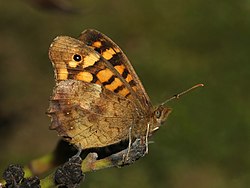| Satyrinae | |
|---|---|
 | |
| Speckled wood, Pararge aegeria | |
| Scientific classification | |
| Kingdom: | Animalia |
| Phylum: | Arthropoda |
| Class: | Insecta |
| Order: | Lepidoptera |
| Family: | Nymphalidae |
| Subfamily: | Satyrinae Boisduval, 1833 |
| Tribes [1] | |
Dirini Contents | |
| Diversity | |
| Over 280 genera, some 2400 species | |
| Synonyms | |
Satyridae | |
The Satyrinae, the satyrines or satyrids, commonly known as the browns, are a subfamily of the Nymphalidae (brush-footed butterflies). They were formerly considered a distinct family, Satyridae. This group contains nearly half of the known diversity of brush-footed butterflies. The true number of the Satyrinae species is estimated to exceed 2,400. [2]